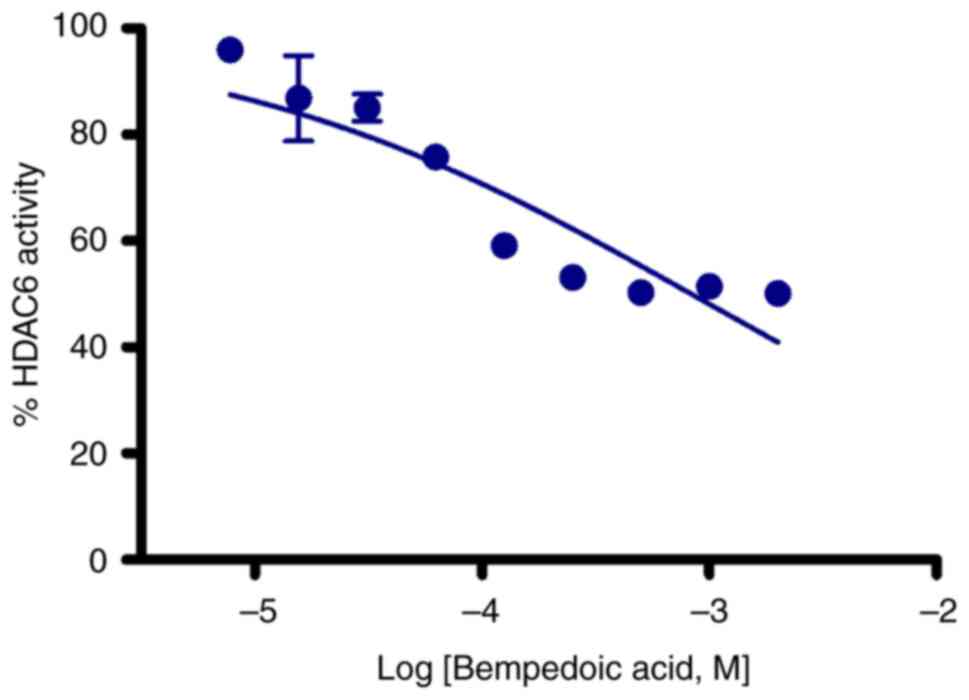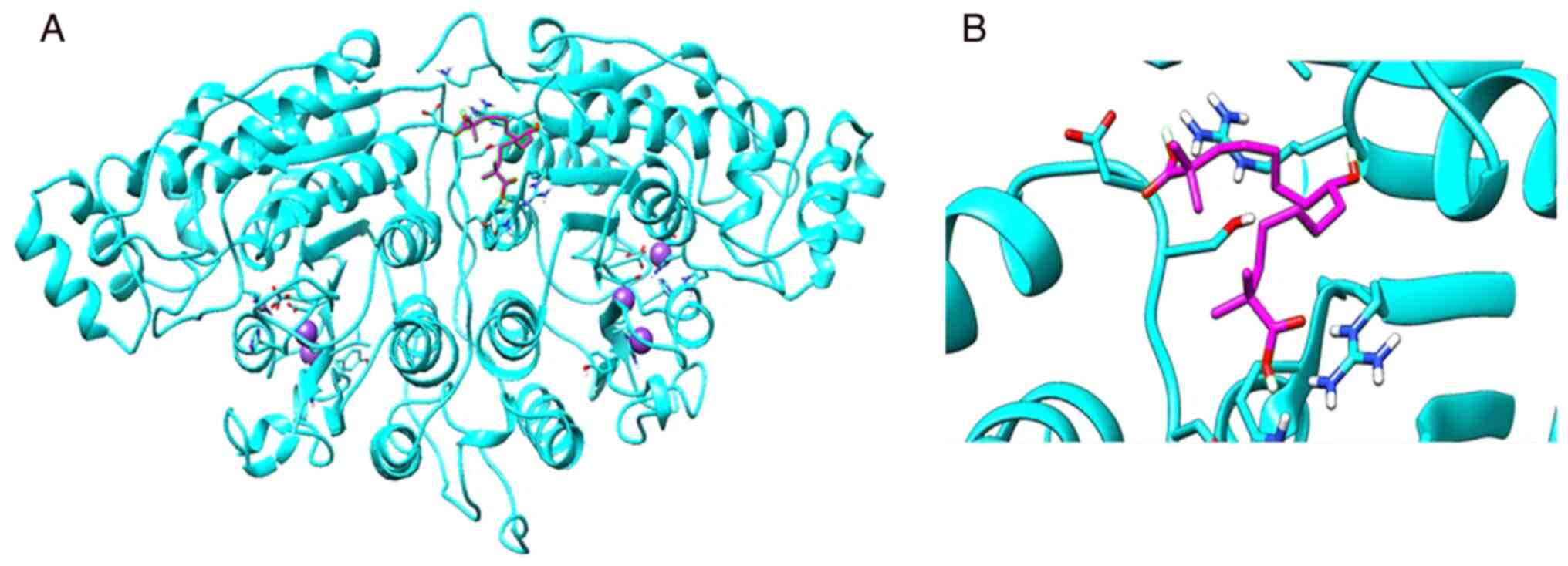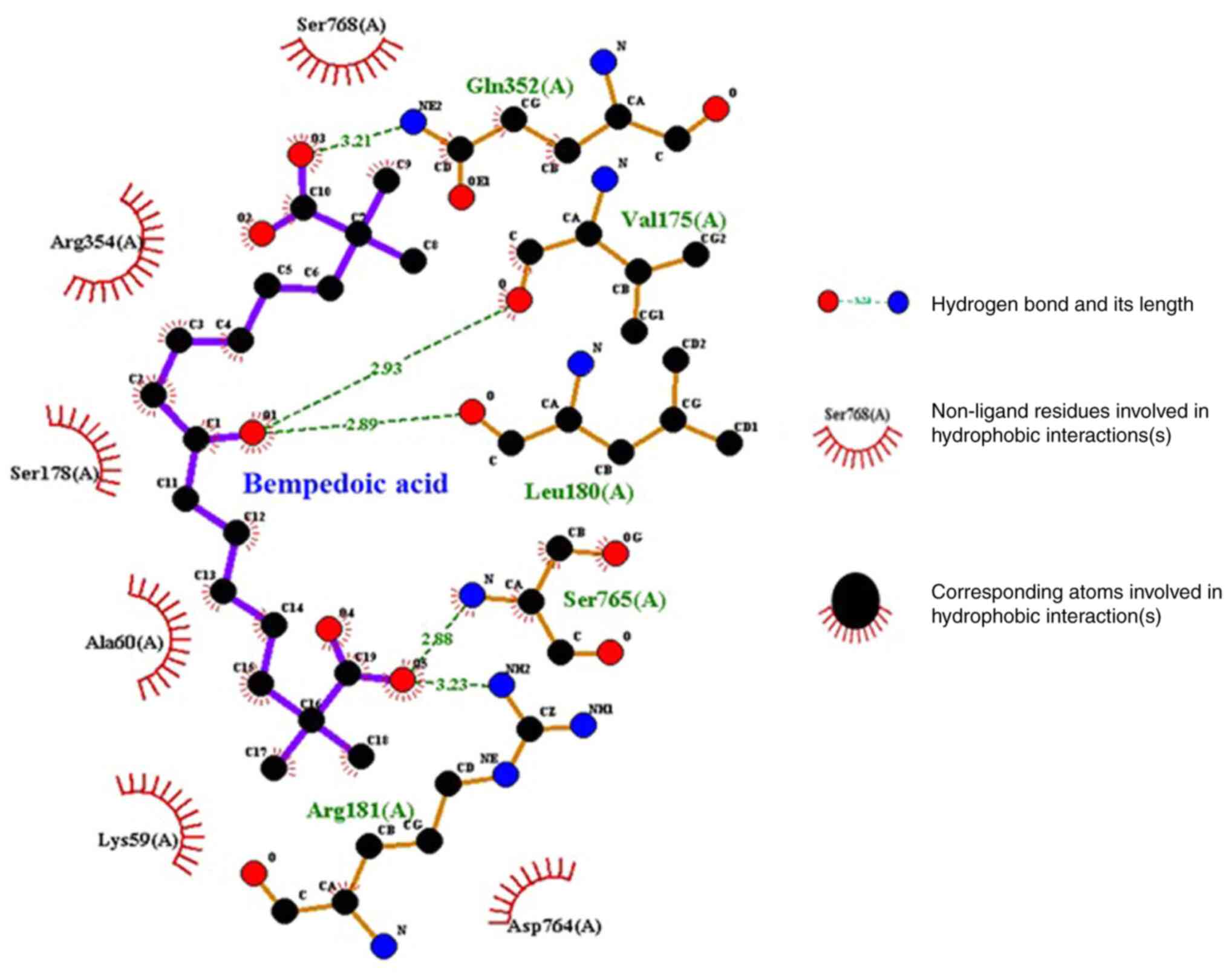Repurposing bempedoic acid as a histone deacetylase 6 inhibitor
- Authors:
- Published online on: April 18, 2023 https://doi.org/10.3892/ije.2023.15
- Article Number: 1
-
Copyright: © Ediriweera et al. This is an open access article distributed under the terms of Creative Commons Attribution License.
Abstract
Introduction
Drug discovery is a tedious and costly process that requires extensive pre-clinical and clinical evaluations. Although numerous drugs exhibit promising pre-clinical efficacies, their clinical efficacies may be unfavorable, resulting in the omission of pre-clinically favorable drug candidates in clinical drug development settings (1,2). Drug repurposing approaches identify novel pharmacological targets of drug candidates that have already obtained regulatory approval for clinical use (3). As the safety, pharmacodynamic and pharmacokinetic profiles of clinically approved drug candidates are already established, the exploration of novel pharmacological properties or targets provides a number of benefits in terms of the cost associated with drug discovery approaches and opens up new arenas in modern drug discovery landscapes (3).
Bempedoic acid was approved by the Food and Drug Administration (FDA) in 2020 for the treatment of refractory hypercholesterolemia (4). Bempedoic is a pro-drug that is activated in the liver by the enzyme very long-chain acyl-CoA synthetase (ACSVL1). The active form of bempedoic acid (bempedoic acid attached to coenzyme A) is an ATP lyase inhibitor (5). ATP lyase plays a key role in cholesterol biosynthesis (6). By inhibiting the activity of ATP lyase, bempedoic acid upregulates the expression of low-density lipoprotein (LDL) cholesterol receptors, decreasing LDL-cholesterol by increasing cholesterol uptake and clearance in the liver (6).
According to epigenetics, chromatin-bound information, other than the information available in DNA sequences, is responsible for the regulation of gene expression (7). Notably, dysregulated epigenetic events are commonly observed in human diseases, rendering them attractive pharmacological targets (8). Of the various epigenetic events, histone acetylation has been well-characterized. Histone acetyltransferases (HATs) and histone deacetylases (HDACs) are involved in the acetylation of histones. HATs mediate acetylation reactions, while HDACs mediate deacetylation reactions in a well-balanced and reversible manner (7). Thus far, 18 different HDACs have been identified in humans (9). There is ample evidence to indicate that HDAC6 plays a key role in a wide range of human diseases, including cancer, neurological diseases, inflammatory diseases and metabolic diseases, thus rendering it an attractive drug target (10,11). To date, various HDAC6 inhibitors have been identified from natural and synthetic sources. The HDAC inhibitory effects of fatty acids have been well-established and numerous fatty acids have been shown to exert HDAC inhibitory effects at millimolar concentrations (i.e., effective concentration for inhibiting HDAC activity) (9,12,13).
The chemical structure of bempedoic acid resembles an α,ω-dicarboxylic acid (14). In a recent study, the authors identified a series of odd-chain fatty acids as HDAC6 inhibitors, which motivated the exploration of the HDAC6 inhibitory effects of new fatty acid candidates (15). Considering the recent findings related to the HDAC6 inhibitory potential of odd-chain fatty acids and the chemical structure of bempedoic acid, it was hypothesized that bempedoic acid can exert HDAC6 inhibitory effects. This hypothesis was tested using a cell-free HDAC6 enzyme assay and confirmed by in silico analysis.
Materials and methods
Chemicals
Bempedoic acid was purchased from Cayman Chemical Company (item no. 26409).
HDAC6 enzyme inhibitory assay
A BioVision HDAC6 Enzyme Cell-Free Inhibitory Assay kit (cat. no. K465; BioVision, Inc.) was used to evaluate the HDAC6 inhibitory potential of bempedoic acid. The assay procedures provided by the manufacturer were followed when conducting the enzyme assays. This HDAC6 enzyme inhibitory assay kit includes HDAC6 synthetic acetylated peptide substrate, human HDAC6 enzyme and a developer. Prior to the assay, bempedoic acid was dissolved in ethanol to yield a dilution series starting from 2 to 0.0078 mM. Fluorescence was measured at excitation/emission wavelengths of 380/490 nm using a microplate reader (Sunrise; Tecan Group, Ltd).
Molecular docking
The crystal structure of HDAC6 comprising nexturastat A was obtained from the Protein Data Bank (PDB ID: 5G0J). Prior to docking, nexturastat A was removed from the active site of HDAC6. The three-dimensional (3D) structure of bempedoic acid (CID: 10472693) was obtained from the PubChem database and energetically pre-optimized using the universal force field (PyRx Python Prescription, version 0.8; The Scripps Research Institute, 2008). The amino acids in the active site were determined using the Computed Atlas for Surface Topography of Proteins (16) and BIOVIA Discovery Studio 4.5 (Dassault Systèmes BIOVIA, Discovery Studio Modeling Environment, Version 4.5. San Diego; Dassault Systèmes; 2015). The docking experiments were performed using the AutoDock Vina module (Molecular Graphics Lab, The Scripps Research Institute). Based on the binding energies, the best-docked pose was selected and 3D images were generated using PyMOL (The PyMOL Molecular Graphics System, Ver.2.5.0; Schrodinger, LLC). The docked complex of HDAC6 was further optimized, validated and explored using the Discovery Studio visualizer (version 21.1.0.20298). The hydrogen bonds and hydrophobic interactions between bempedoic acid and HDAC6 were analyzed using the LigPlot program (17).
Data analysis
The enzyme inhibitory assay was conducted in triplicate. The results are presented as the mean ± standard deviation (SD). GraphPad Prism software was used to generate enzyme inhibitory graphs and to obtain the half maximal inhibitory concentration (IC50) of bempedoic acid.
Results
HDAC6 enzyme inhibitory effects of bempedoic acid
The effect of bempedoic acid on HDAC6 activity was assessed in vitro. As illustrated in Fig. 1, bempedoic acid exerted a concentration-dependent HDAC6 inhibitory effect with an IC50 value of ~0.8 mM.
Molecular docking
For in silico analysis, the 3D structure of Danio rerio HDAC6, 5G0J.pdb, was used as the 3D structure of Homo sapiens HDAC6 (containing two catalytic domains) has not been deposited in the PDB (15). The basic molecular structure of HDAC6 contains two catalytic domains (CD1 and CD2) (18). Among these catalytic domains, CD2 exhibits broad substrate specificity and has been used exclusively to develop HDAC6-selective inhibitors (19). The docking of bempedoic acid to HDAC6 exhibited binding energies ranging from -4.7 to -5.1 kcal/mol. The complex with the lowest binding energy was selected for further analysis. As shown in Fig. 2, bempedoic acid is docked into the active pocket of the catalytic domain of HDAC6.
LigPlot analysis revealed molecular interactions (hydrogen bonds and hydrophobic interactions) between bempedoic acid and the catalytic domain of HDAC6 (Fig. 3). Furthermore, the LigPlot analysis revealed that five residues, Gln352, Val175, Leu180, Ser765 and Arg181, are involved in hydrogen bonds, and six residues, Ser768, Arg354, Ser178, Ala60, Lys59 and Asp764, are involved in hydrophobic interactions with bempedoic acid. These hydrogen bonds and hydrophobic interactions may play an essential role in lead optimization and may thus enhance the affinity of bempedoic acid for HDAC6.
Discussion
In the present study, for the first time, to the best of our knowledge, bempedoic acid was repurposed as a HDAC6 inhibitor. Bempedoic acid is an FDA-approved cholesterol-lowering agent (4). In the liver, with the aid of the enzyme ACSVL1, bempedoic acid is converted to its active form, which is an ATP citrate lyase inhibitor (5). The dysregulated activity or overexpression of HDAC6 have been reported in a range of human diseases, rendering HDAC6 an interesting drug target (10,11).
A large number of isoform-specific and pan-HDAC inhibitor proteins belonging to four major chemical classes have been identified: Benzamides, fatty acids, hydroxamates and cyclic tetrapeptides (7). A recent study by the authors identified a series of odd-chain fatty acids, including valeric acid (C5:0), heptanoic acid (C7:0), nonanoic acid (C9;0), undecanoic acid (C11:0) and pentadecanoic acid (C15:0) as HDAC6 inhibitors (15). Of these, pentadecanoic acid exerted more potent HDAC6 inhibitory effects with binding energies ranging from -3.95 to -2.90 kcal/mol. The HDAC3 and HDAC7 enzyme inhibitory effects of short-chain fatty acids (namely, valeric, propionic, butyric, caproic and 4-methylvaleric acids) have been previously investigated (20). Butyric acid was identified as the most potent HDAC3 inhibitor among the fatty acids tested. Fass et al (21) demonstrated the class I and class IIa HDAC inhibitory potentials of the short-chain fatty acids, butyric acid and valporic acid. The branched-chain fatty acids 2,2-dimethylbutyric acid, 2-ethylbutyric acid, and valproic acid, and the un-branched fatty acids propionic acid, valeric acid and butyric acid, were previously identified as weak and equipotent HDAC inhibitors, respectively (22). In a recent study, valeric acid was identified as a HDAC3 inhibitor (23).
In the present study, the in vitro HDAC6 enzyme inhibitory assay indicated that bempedoic acid can inhibit the activity of HDAC6 at millimolar concentrations. According to the in silico findings, bempedoic acid docked into the active pocket of the catalytic domain of HDAC6 and was involved in the formation of hydrogen bonds and hydrophobic interactions with HDAC6 residues, which may explain the HDAC6 inhibitory effects of bempedoic acid. Notably, bempedoic acid exhibited a lower binding energy (-4.7 to -5.1 kcal/mol) compared to pentadecanoic acid, which was identified as the most potent HDAC6 inhibitor in a recent by the authors (15).
Bempedoic acid is rapidly absorbed in the small intestine and reaches a maximum plasma concentration of 20.6±6.1 µg/ml (0.059 mM) following multiple-dose administration at 180 mg/day (24). According to the enzyme assay results of the present study, bempedoic acid at concentrations near ~0.059 mM also exerted HDAC6 inhibitory effects, indicating that the HDAC6 inhibitory action of bempedoic acid is likely to occur in body tissues. According to the FDA drug label for bempedoic acid, bempedoic acid and its conjugates are detected in plasma, with bempedoic acid being the most prominent compound, accounting for almost 46% of the area under the curve (AUC0-48 h) (25). Although the pre-clinical findings are meaningful, it is critical to assess the HDAC isoform specificities of bempedoic acid, its active form and conjugates. Moreover, the preliminary findings of the present study may provide an important foundation with which to rationalize the HDAC6 inhibitory effects of bempedoic acid and warrant additional investigations to explore the detailed epigenetic mechanisms associated with bempedoic acid and its active form in cell-based systems. A recent study demonstrated that bempedoic acid can reprogram the epigenetic and transcriptional machineries of ATP citrate lyase-associated genes in hepatocytes (26), further supporting the current preliminary experimental findings. Taken together, the present study opens up new perspectives for the exploration of the epigenetic effects of bempedoic acid in human diseases, as HDAC6 activity and expression are frequently altered in a range of human diseases (10,11).
In conclusion, to the best of our knowledge, the present study reports for the first time that bempedoic acid, an FDA-approved cholesterol-lowering drug, functions as an HDAC6 enzyme inhibitor. Similar to several other fatty acids, bempedoic acid exerts HDAC6 inhibitory effects at millimolar concentrations.
Acknowledgements
Not applicable.
Funding
Funding: The present study was supported by grants from the Basic Science Research Program through the National Research Foundation of Korea funded by the Ministry of Education (no. 2016R1A6A1A03012862) and the UNESCO-TWAS and the Swedish International Development Cooperation Agency (Sida; no. 22-140 RG/BIO/AS_I).
Availability of the data and materials
The datasets used and/or analyzed during the current study are available from the corresponding author upon reasonable request.
Authors' contributions
MKE and SKC designed the study. PR and MKE performed the experiments. MKE and PR analyzed the data and wrote the manuscript. SKC supervised the study and revised the manuscript. All authors have read and approved the final manuscript. MKE and SKC confirm the authenticity of all the raw data.
Ethics approval and consent to participate
Not applicable.
Patient consent for publication
Not applicable.
Competing interests
The authors declare that they have no competing interests.
References
|
Hughes JP, Rees S, Kalindjian SB and Philpott KL: Principles of early drug discovery. Br J Pharmacol. 162:1239–1249. 2011.PubMed/NCBI View Article : Google Scholar | |
|
Ediriweera MK, Tennekoon KH and Samarakoon SR: In vitro assays and techniques utilized in anticancer drug discovery. J Appl Toxicol. 39:38–71. 2019.PubMed/NCBI View Article : Google Scholar | |
|
Pushpakom S, Iorio F, Eyers PA, Escott KJ, Hopper S, Wells A, Doig A, Guilliams T, Latimer J, McNamee C, et al: Drug repurposing: Progress, challenges and recommendations. Nat Rev Drug Discov. 18:41–58. 2019.PubMed/NCBI View Article : Google Scholar | |
|
Marrs JC and Anderson SL: Bempedoic acid for the treatment of dyslipidemia. Drugs Context. 9(2020-6-5)2020.PubMed/NCBI View Article : Google Scholar | |
|
Ray KK, Bays HE, Catapano AL, Lalwani ND, Bloedon LT, Sterling LR, Robinson PL and Ballantyne CM: CLEAR Harmony Trial. Safety and efficacy of bempedoic acid to reduce LDL cholesterol. N Engl J Med. 380:1022–32. 2019.PubMed/NCBI View Article : Google Scholar | |
|
Feng X, Zhang L, Xu S and Shen AZ: ATP-citrate lyase (ACLY) in lipid metabolism and atherosclerosis: An updated review. Prog Lipid Res. 77(101006)2020.PubMed/NCBI View Article : Google Scholar | |
|
Ediriweera MK, Tennekoon KH and Samarakoon SR: Emerging role of histone deacetylase inhibitors as anti-breast-cancer agents. Drug Discov Today. 24:685–702. 2019.PubMed/NCBI View Article : Google Scholar | |
|
Hatchwell E and Greally JM: The potential role of epigenomic dysregulation in complex human disease. Trends Genet. 23:588–95. 2007.PubMed/NCBI View Article : Google Scholar | |
|
Ediriweera MK and Cho SK: Targeting miRNAs by histone deacetylase inhibitors (HDACi): Rationalizing epigenetics-based therapies for breast cancer. Pharmacol Ther. 206(107437)2020.PubMed/NCBI View Article : Google Scholar | |
|
Pulya S, Amin SA, Adhikari N, Biswas S, Jha T and Ghosh B: HDAC6 as privileged target in drug discovery: A perspective. Pharmacol Res. 163(105274)2021.PubMed/NCBI View Article : Google Scholar | |
|
Batchu SN, Brijmohan AS and Advani A: The therapeutic hope for HDAC6 inhibitors in malignancy and chronic disease. Clinical Sci. 130:987–1003. 2016.PubMed/NCBI View Article : Google Scholar | |
|
Waldecker M, Kautenburger T, Daumann H, Busch C and Schrenk D: Inhibition of histone-deacetylase activity by short-chain fatty acids and some polyphenol metabolites formed in the colon. J Nutr Biochem. 19:587–593. 2008.PubMed/NCBI View Article : Google Scholar | |
|
Xu WS, Parmigiani RB and Marks PA: Histone deacetylase inhibitors: Molecular mechanisms of action. Oncogene. 26:5541–5552. 2007.PubMed/NCBI View Article : Google Scholar | |
|
Oniciu DC and Myers JL: Bempedoic acid and the fraudulent fatty acid family: The gold rush to cardiovascular therapies in the new millennium. Org Process Res Dev. 25:365–372. 2021. | |
|
Ediriweera MK, To NB, Lim Y and Cho SK: Odd-chain fatty acids as novel histone deacetylase 6 (HDAC6) inhibitors. Biochimie. 186:147–156. 2021.PubMed/NCBI View Article : Google Scholar | |
|
Tian W, Chen C, Lei X, Zhao J and Liang J: CASTp 3.0: Computed atlas of surface topography of proteins. Nucleic Acids Res. 46:W363–W367. 2018.PubMed/NCBI View Article : Google Scholar | |
|
Laskowski RA and Swindells MB: LigPlot+: Multiple ligand-protein interaction diagrams for drug discovery. J Chem Inf Model. 51:2778–2786. 2011.PubMed/NCBI View Article : Google Scholar | |
|
Osko JD and Christianson DW: Structural determinants of affinity and selectivity in the binding of inhibitors to histone deacetylase 6. Bioorg Med Chem Lett. 30(127023)2020.PubMed/NCBI View Article : Google Scholar | |
|
Osko JD and Christianson DW: Structural basis of catalysis and inhibition of HDAC6 CD1, the enigmatic catalytic domain of histone deacetylase 6. Biochemistry. 58:4912–4924. 2019.PubMed/NCBI View Article : Google Scholar | |
|
Ho RH, Chan JC, Fan H, Kioh DY, Lee BW and Chan EC: In silico and in vitro interactions between short chain fatty acids and human histone deacetylases. Biochemistry. 56:4871–4878. 2017.PubMed/NCBI View Article : Google Scholar | |
|
Fass DM, Shah R, Ghosh B, Hennig K, Norton S, Zhao WN, Reis SA, Klein PS, Mazitschek R, Maglathlin RL, et al: Effect of inhibiting histone deacetylase with short-chain carboxylic acids and their hydroxamic acid analogs on vertebrate development and neuronal chromatin. ACS Med Chem Lett. 2:39–42. 2010.PubMed/NCBI View Article : Google Scholar | |
|
Gilbert KM, DeLoose A, Valentine JL and Fifer EK: Structure-activity relationship between carboxylic acids and T cell cycle blockade. Life Sci. 78:2159–2165. 2006.PubMed/NCBI View Article : Google Scholar | |
|
Han R, Yang H, Li Y, Ling C and Lu L: Valeric acid acts as a novel HDAC3 inhibitor against prostate cancer. Medical Oncol. 39(213)2022.PubMed/NCBI View Article : Google Scholar | |
|
Markham A: Bempedoic acid: First approval. Drugs. 80:747–753. 2020.PubMed/NCBI View Article : Google Scholar | |
|
Esperion Therapeutics Inc.: NEXLETOL (bempedoic acid): tablets, for oral use. Initial U.S. Approval: 2020. https://www.accessdata.fda.gov/drugsatfda_docs/label/2020/211616s000lbl.pdf. Accessed December 12, 2022. | |
|
Rose A, Rodriguez-Aguilera JR, Schicht G, Lohrenz A, Tvardovskiy A, Büscher J, Hoffmann A, Damm G, Laufs U, Seehofer D, et al: The impact of cholesterol lowering drugs on metabolism and epigenetics. Atherosclerosis. 355:179–180. 2022. |











